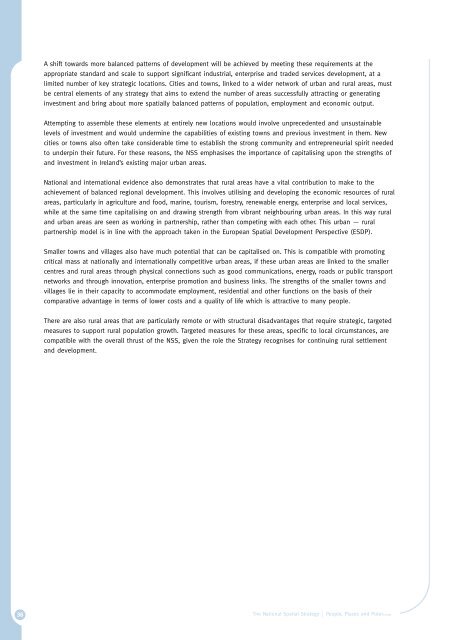National Spatial Strategy For Ireland 2002 - 2020 - Full ... - Kildare.ie
National Spatial Strategy For Ireland 2002 - 2020 - Full ... - Kildare.ie
National Spatial Strategy For Ireland 2002 - 2020 - Full ... - Kildare.ie
You also want an ePaper? Increase the reach of your titles
YUMPU automatically turns print PDFs into web optimized ePapers that Google loves.
36<br />
A shift towards more balanced patterns of development will be ach<strong>ie</strong>ved by meeting these requirements at the<br />
appropriate standard and scale to support significant industrial, enterprise and traded services development, at a<br />
limited number of key strategic locations. Cit<strong>ie</strong>s and towns, linked to a wider network of urban and rural areas, must<br />
be central elements of any strategy that aims to extend the number of areas successfully attracting or generating<br />
investment and bring about more spatially balanced patterns of population, employment and economic output.<br />
Attempting to assemble these elements at entirely new locations would involve unprecedented and unsustainable<br />
levels of investment and would undermine the capabilit<strong>ie</strong>s of existing towns and previous investment in them. New<br />
cit<strong>ie</strong>s or towns also often take considerable time to establish the strong community and entrepreneurial spirit needed<br />
to underpin their future. <strong>For</strong> these reasons, the NSS emphasises the importance of capitalising upon the strengths of<br />
and investment in <strong>Ireland</strong>’s existing major urban areas.<br />
<strong>National</strong> and international evidence also demonstrates that rural areas have a vital contribution to make to the<br />
ach<strong>ie</strong>vement of balanced regional development. This involves utilising and developing the economic resources of rural<br />
areas, particularly in agriculture and food, marine, tourism, forestry, renewable energy, enterprise and local services,<br />
while at the same time capitalising on and drawing strength from vibrant neighbouring urban areas. In this way rural<br />
and urban areas are seen as working in partnership, rather than competing with each other. This urban — rural<br />
partnership model is in line with the approach taken in the European <strong>Spatial</strong> Development Perspective (ESDP).<br />
Smaller towns and villages also have much potential that can be capitalised on. This is compatible with promoting<br />
critical mass at nationally and internationally competitive urban areas, if these urban areas are linked to the smaller<br />
centres and rural areas through physical connections such as good communications, energy, roads or public transport<br />
networks and through innovation, enterprise promotion and business links. The strengths of the smaller towns and<br />
villages l<strong>ie</strong> in their capacity to accommodate employment, residential and other functions on the basis of their<br />
comparative advantage in terms of lower costs and a quality of life which is attractive to many people.<br />
There are also rural areas that are particularly remote or with structural disadvantages that require strategic, targeted<br />
measures to support rural population growth. Targeted measures for these areas, specific to local circumstances, are<br />
compatible with the overall thrust of the NSS, given the role the <strong>Strategy</strong> recognises for continuing rural settlement<br />
and development.<br />
The <strong>National</strong> <strong>Spatial</strong> <strong>Strategy</strong> | People, Places and Potential
















